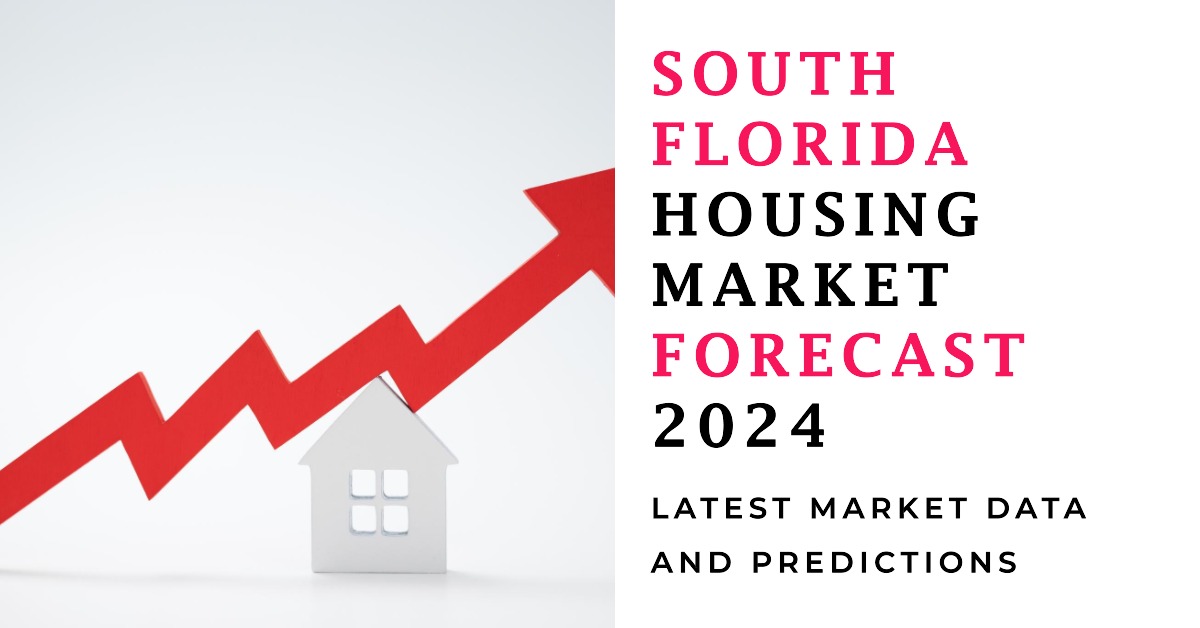Will it Crash in 2024?
The current dynamics of the South Florida housing market present a nuanced scenario. The market favors sellers for single-family homes but offers a more balanced environment for condo transactions, providing opportunities for both buyers and sellers. While challenges such as elevated mortgage rates and low inventory exist, the data suggests a market that is adapting to changing conditions.
The forecasted growth of home sales in South Florida is +7% year-over-year by the end of 2024 while prices will continue to appreciate at a modest pace of 5%. The median prices in Miami-Dade County have experienced substantial year-over-year increases. Single-family home median prices surged by 11.8%, reaching $615,000, while condo median prices increased by 6.3%, reaching $420,000. The longevity of this streak, with median prices consistently rising for 144 consecutive months, reflects the resilience and growth potential of the market.
How is the South Florida housing market doing currently?
According to the data released by the MIAMI Association of Realtors and the Multiple Listing Service, Miami’s existing condo sales in the price range of $400,000 to $600,000 witnessed a notable 8.8% year-over-year increase, totaling 137 transactions in November 2023. What makes this surge even more noteworthy is the fact that all-cash deals accounted for a substantial 50.2% of all condo sales, a figure nearly double the national average.
“Mortgage rates falling more than 1% since October’s peak is major news for a high-demand real estate market like Miami,” remarked Ines Hegedus-Garcia, the Chairman of the Board at MIAMI. “We should begin to see the impact in sales numbers in early 2024. Low inventory in key price points has impacted home sales, but we are beginning to see that change. New listings have risen for three consecutive months.”
Southeast Florida Home Sales Projections for 2024
Looking ahead, Gay Cororaton, Chief Economist at MIAMI REALTORS®, forecasts a positive outlook for Southeast Florida’s home sales. With an anticipated 7% year-over-year expansion by the end of 2024, driven by a decline in mortgage rates to 5.25%, the market seems poised for growth. Cororaton predicts that prices will continue to appreciate at a modest pace of 5%, with varying impacts across different market segments.
“In the low to mid-price segment of the market, the lower mortgage rates will drive up demand from first-time buyers and renter households. In the high-price and luxury segment, the wealth effect from rising stock prices, a pickup in economic growth in 2024, and sustained migration of high-income households into Southeast Florida will push up demand,” explained Cororaton.
Impact of Elevated Mortgage Rates and Low Inventory
However, the data from November 2023 also indicates challenges in the market. Total Miami-Dade sales experienced a 7.8% decrease, dropping from 1,791 to 1,651, primarily attributed to elevated mortgage rates and low inventory in key price points. The statistics do not include South Florida’s robust developer new construction market and volume, which adds another layer to the complexity of the market dynamics.
Miami single-family home sales saw a 1.5% year-over-year decrease, while existing condo sales experienced a more significant decline of 12%. The condo market, in particular, felt the impact of insufficient inventory at key price points and elevated mortgage rates.
Positive Signs: Rise in New Listings
Despite the challenges, there are positive indicators in the market. Miami saw a 7.7% year-over-year increase in new listings in November 2023, rising from 2,982 to 3,211. This surge in fresh supply provides buyers with more options, potentially alleviating some of the pressure in the seller’s market that Miami-Dade has been experiencing.
New listings for single-family homes increased by 0.97%, while condo new listings recorded a substantial 11.93% year-over-year jump, reflecting a diversified market activity.
Inventory Dynamics: Striking Imbalance
One critical factor impacting the market is the inventory levels. In November 2023, the inventory of single-family homes decreased by 10.1% year-over-year, while condominium inventory increased by 12%. This results in a 42.9% deficit from the historical average, indicating a challenging environment for both buyers and sellers.
The months’ supply of inventory for single-family homes stands at 4.4 months, signaling a seller’s market. In contrast, existing condominiums face a more balanced scenario with a 6.8 months’ supply, creating a nuanced landscape for real estate transactions.
South Florida Home Price Trends: Median Prices Continue to Rise
Amidst the fluctuations, median prices in Miami-Dade County tell a compelling story. Single-family home median prices increased by a robust 11.8% year-over-year in November 2023, reaching $615,000. Impressively, this marks the 144th consecutive month of price appreciation, establishing a record streak lasting 12 years.
On the condo front, median prices increased by 6.3% year-over-year, from $395,000 to $420,000. The market has demonstrated resilience, maintaining or increasing condo median prices in 144 of the last 150 months.
According to the latest US CoreLogic S&P Case-Shiller Index, Miami is tied for No. 3 in the U.S. for annual home price appreciation, showcasing the city’s robust real estate market despite the challenges.
South Florida’s Incredible Wealth Migration
The surge in local home prices in South Florida is closely tied to the phenomenon of wealth migration. According to MIAMI REALTORS® analysis of the 2020-2021 migration data released by the Internal Revenue Service, in-migration contributed significantly to the region’s economic landscape. In 2021, South Florida’s household income experienced a remarkable boost of $16 billion, highlighting the economic magnetism of the area.
Breaking down the numbers, new households moving into Miami-Dade in 2021 had an average adjusted gross income of $229,300, while Broward County and Palm Beach County saw new households with average incomes of $102,600 and $242,200, respectively. This influx of high-income households has not only influenced the real estate market but has broader economic implications for the region.
Economic Impact of Home Sales
Understanding the economic impact of home sales is crucial in assessing the overall health of the real estate market. Each home sale sets in motion a chain of economic activities, including income generated from real estate industries, expenditures related to home purchase, multiplier effects, and new construction.
According to the National Association of Realtors (NAR), the total economic impact of a typical Florida home sale is $122,000. In November 2023 alone, Miami-Dade sold 1,651 homes, resulting in a substantial local economic impact of $201 million. The total dollar volume for Miami reached $1.33 billion during the same period, with single-family home dollar volume increasing by 8.8% year-over-year to $698 million. However, condo dollar volume decreased by 9.7% year-over-year to $637 million, indicating variations in market segments.
Is Now a Good Time to Buy a House in South Florida?
The decision to buy a house depends on various factors, including personal circumstances and market conditions. With falling mortgage rates anticipated in 2024 and a diversified market with new listings on the rise, first-time buyers and those in the mid-price segment may find favorable conditions. However, buyers should carefully consider their financial readiness and engage with the market with a strategic approach, especially in the context of the unique dynamics of South Florida’s real estate landscape.
South Florida Housing Market Forecast for 2024
Price appreciation has been a constant in South Florida, with median prices steadily increasing. The influx of wealth migration has significantly contributed to the region’s economic growth, boosting household incomes and strengthening the real estate market.
Forecast
As we look ahead to 2024, several key trends are expected to shape the South Florida housing market:
- Continued Resilience: The market is likely to remain resilient, with high-value transactions and cash buyers driving growth.
- Divergence in Sales: Single-family home sales may continue to outpace condo sales, influenced by inventory constraints and mortgage rates.
- New Listings and Inventory: The rise in new listings will provide buyers with more options, but inventory challenges may persist.
- Market Attractiveness: South Florida’s appeal to domestic and international buyers is expected to endure, further fueling the market.
- Price Appreciation: Home prices are likely to continue their upward trajectory, particularly in the luxury segment.
- Wealth Migration: The influx of affluent households into South Florida will contribute to economic growth and real estate demand.
While the South Florida housing market faces challenges, it remains a dynamic and attractive destination for real estate investment. The region’s ability to adapt and thrive, even in the face of rising mortgage rates, positions it as a promising market for 2024.
If mortgage rates continue to rise next year, affordability will deteriorate. While we believe the South Florida market will remain strong in 2024 and do not anticipate a meltdown, waiting until there is even more inventory and loan rates are much higher would merely prolong the sales process. And we believe that by the end of the year, the days on the market will have increased significantly.
It will take far longer to sell a property than people have become accustomed to in the previous two years. This is an excellent opportunity to be both a buyer and a seller. If you’ve been sitting on the sidelines, now is the moment to act. The demand for real estate in South Florida is being driven by new residents and corporate relocations from high-tax metropolitan regions such as New York.
While rising home prices may be terrible news for many homeowners, it’s good news for rental property investors, helping to explain why rental growth and demand in South Florida are so high. South Florida has around 100 cities and villages, including Miami, Fort Lauderdale, West Palm Beach, Boca Raton, Boynton Beach, and North Miami.
South Florida, sometimes known as the Greater Miami Area, is the seventh-largest metropolitan area in the United States and the second-largest in the southeastern United States, trailing only the Washington-Arlington-Alexandria MSA. More than 6.7 million people live in the region, which encompasses more than 6,000 square miles and three counties: Miami-Dade, Broward, and Palm Beach.
It is important to note that the housing market is influenced by various factors, including economic conditions, government policies, and global events. Therefore, this forecast is subject to change based on future developments. Monitoring the market closely and adapting strategies accordingly will be essential for buyers, sellers, and industry professionals operating in the South Florida housing market.
Will the South Florida Housing Market Crash?
The housing market in South Florida is still strong and unlikely to crash in 2024. Several factors drive housing demand in South Florida:
Climate: South Florida has a warm, tropical climate that attracts many retirees and snowbirds, who are looking for a place to escape the cold weather during the winter months. This demand for seasonal housing helps to drive up housing prices in the region.
Tourism: South Florida is home to many popular tourist destinations such as Miami, Fort Lauderdale, and West Palm Beach. The steady flow of tourists in the area helps to boost the economy and creates a demand for both short-term and long-term rental properties.
Job Market: South Florida has a diverse economy, anchored by industries such as finance, healthcare, and real estate. The strong job market in the region helps to attract new residents and supports the demand for housing.
International Buyers: South Florida is a popular destination for international buyers, particularly those from Latin America and Europe. The strong demand from these buyers helps to drive up housing prices in the region.
Demographics: South Florida’s population is growing and is expected to continue to grow in the future, which is a driver for housing demand. Additionally, the increasing population of retirees in the area is also driving demand for housing.
Bottom line: We’re not seeing any major home price decline or crash in the South Florida housing market just yet. The current supply of homes in South Florida still favors sellers. In the long run, it is hoped that higher interest rates will result in more days on the market (which gives buyers more choices). The price rise will ultimately slow as a result of higher interest rates. With the deceleration of price rise, total inventory might expand in the future. Historically, inventory grows six months after interest rates rise, but today’s market is unlike any other.
Sources:



